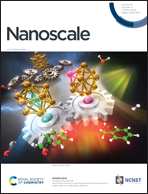An oriented tube array porous carbon anode prepared using a self-blowing mold of salt templates for high-rate potassium storage†
Abstract
Porous carbon materials with oriented porosity are very useful in ion batteries, but their high cost and complex fabrication hinder their wide application. In this paper, we used cheap and water-soluble NaHCO3 grains to prepare unique porous carbon with an orderly arranged tube array via one-step carbonization. During the preparation process, a novel self-blowing mold of salt templates was discovered for the first time, and the resulting numerous high-speed gas jets can act as gas state templates to induce the formation of the oriented porous carbon into a mesoscale tube array with rich micropores. Besides, the amount of C![[double bond, length as m-dash]](https://www.rsc.org/images/entities/char_e001.gif) O functional groups has been enhanced greatly by the chemical activation of H2O and CO2 derived from the decomposition of NaHCO3, which can improve the reversible specific capacity of the electrode by forming a C–O–K compound with potassium. Thanks to the coupling effect of the hierarchical porous structure with an orderly tube array and rich C
O functional groups has been enhanced greatly by the chemical activation of H2O and CO2 derived from the decomposition of NaHCO3, which can improve the reversible specific capacity of the electrode by forming a C–O–K compound with potassium. Thanks to the coupling effect of the hierarchical porous structure with an orderly tube array and rich C![[double bond, length as m-dash]](https://www.rsc.org/images/entities/char_e001.gif) O functional groups, the obtained porous carbon materials exhibited excellent kinetics and impressive rate capability as the anode of potassium-ion batteries (PIBs) with high capacities of 209 mA h g−1 at 10 A g−1 and 156 mA h g−1 at 30 A g−1. This work not only provides a facile, green, sustainable approach to fabricating novel carbon materials, but also demonstrates the promising prospect of oriented porous carbon in exploring advanced electrode materials for PIBs.
O functional groups, the obtained porous carbon materials exhibited excellent kinetics and impressive rate capability as the anode of potassium-ion batteries (PIBs) with high capacities of 209 mA h g−1 at 10 A g−1 and 156 mA h g−1 at 30 A g−1. This work not only provides a facile, green, sustainable approach to fabricating novel carbon materials, but also demonstrates the promising prospect of oriented porous carbon in exploring advanced electrode materials for PIBs.



 Please wait while we load your content...
Please wait while we load your content...